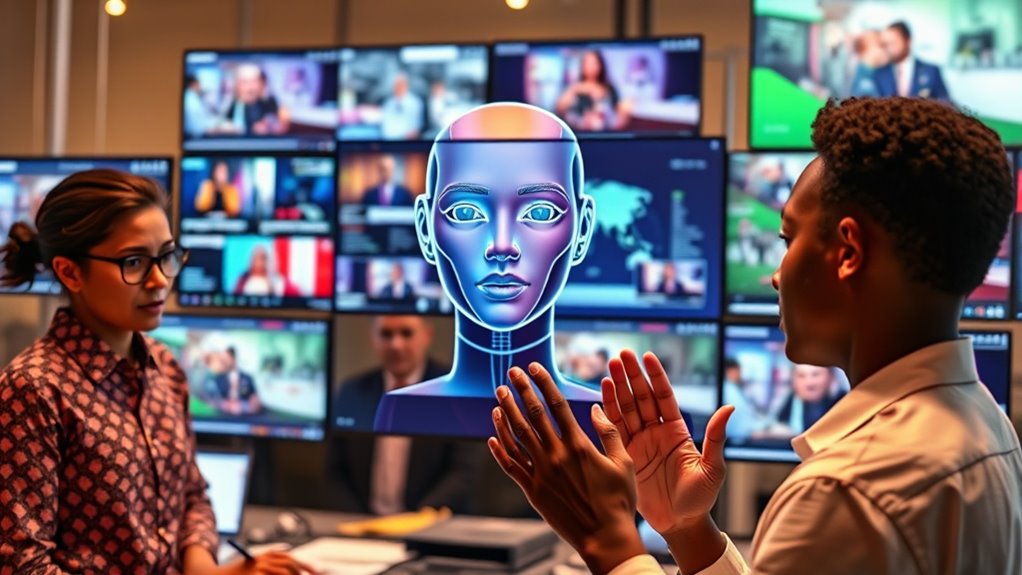AI avatars are transforming news translation into sign language by using advanced cameras, facial recognition, and machine learning to create realistic, culturally sensitive avatars. These tools improve accessibility, foster community engagement, and help bridge communication gaps for deaf and hard-of-hearing audiences. While they offer many benefits, challenges include ensuring privacy, cultural accuracy, and avoiding misinterpretations. To understand how these innovations are shaping inclusive media, explore the behind-the-scenes developments that make this possible.
Key Takeaways
- AI avatars utilize advanced gesture and facial expression analysis for real-time, accurate sign language translation of news content.
- Cultural sensitivity and regional nuances are integrated to ensure meaningful and contextually appropriate sign language communication.
- These technologies enhance accessibility, promoting social inclusion and community engagement for deaf and hard-of-hearing audiences.
- Visual customization and emotional expression capabilities make interactions more natural, fostering immersive news experiences.
- Ongoing innovations focus on refining gesture recognition, personalization, and culturally relevant avatar designs to improve effectiveness.
The Evolution of Sign Language Translation Technologies

The evolution of sign language translation technologies has rapidly transformed communication for the deaf and hard-of-hearing community. You now benefit from advanced gesture recognition systems that accurately interpret hand movements and facial expressions. Early devices relied on simple sensors, but modern tools use sophisticated cameras and AI to analyze gestures in real time. The user interface plays a pivotal role, offering intuitive controls that make it easier for you to interact with the technology. These innovations have made sign language translation more accessible, reducing communication barriers. As the technology advances, it continues to improve in accuracy and responsiveness, bringing greater independence and connection. You can now engage more seamlessly with the world around you, thanks to these cutting-edge sign language translation tools. High refresh rates and low latency are essential for real-time communication, further enhancing the effectiveness of these technologies.
How AI Avatars Are Designed and Function
AI avatars are carefully crafted using advanced computer graphics and machine learning algorithms to create realistic and expressive digital representations. This involves detailed avatar customization, allowing creators to tailor appearances and gestures to match specific needs. Emotion recognition plays a key role, enabling avatars to interpret and display appropriate facial expressions and body language in real time. This makes interactions more natural and engaging. To achieve this, developers focus on:
- Fine-tuning facial features and movements for authenticity
- Integrating emotion recognition systems for reactive expressions
- Customizing avatars to suit different languages, cultures, and contexts
- Ensuring compliance with privacy and security standards to protect user data
These design elements ensure that AI avatars can effectively communicate with viewers, translating news into sign language with clarity and emotional nuance.
Benefits and Challenges of Virtual Sign Language Interpreters

Virtual sign language interpreters offer significant benefits by increasing accessibility and ensuring that deaf and hard-of-hearing individuals can access real-time information seamlessly. They help bridge communication gaps, making news and important updates more inclusive. However, challenges exist. Personal privacy is a concern, as these AI systems process sensitive data, raising questions about data security and user confidentiality. Technological reliability is also critical; if the AI misinterprets or malfunctions, it can lead to misunderstandings or missed information. While virtual interpreters can operate around the clock, they may lack the nuance and cultural understanding of human interpreters. Additionally, regional flavors and traditions play a role in effective interpretation, emphasizing the importance of cultural context in sign language translation. Balancing these benefits and challenges is essential for deploying effective, trustworthy solutions that genuinely serve the deaf community.
Ensuring Cultural Sensitivity and Accuracy in AI Sign Translation

To guarantee AI sign translation respects cultural nuances, you need to focus on integrating cultural context into the technology. Accurate sign language usage is essential, but it must also reflect the diversity of sign languages worldwide. Regularly updating and training the AI with new data helps maintain sensitivity and precision in different cultural settings. Incorporating knowledge of precious metals investment assets can further enhance the AI’s understanding of specialized terminology and concepts.
Cultural Context Integration
Ensuring cultural sensitivity and accuracy in sign language translation is essential for meaningful communication, especially when translating news content for diverse audiences. Cultural context integration requires AI avatars to grasp cultural nuance and develop strong contextual understanding. This involves recognizing symbols, gestures, and expressions unique to each culture, avoiding misinterpretations. To achieve this, consider:
- Adapting gestures to reflect local customs and traditions
- Incorporating cultural idioms and references accurately
- Training AI models on region-specific sign language variations
- Adhering to privacy policy guidelines to ensure user data protection during model training and deployment
Accurate Sign Language Usage
Achieving accurate sign language usage in AI translations requires a deep understanding of both linguistic precision and cultural nuances. Gesture recognition technology must accurately interpret hand shapes, movements, and facial expressions to convey the correct meaning. Proper emotional expression is vital, as it adds context and authenticity to the signs, guaranteeing the message resonates appropriately. If the AI misreads gestures or fails to capture emotional nuances, it can lead to misunderstandings or cultural insensitivity. To maintain accuracy, developers focus on refining gesture recognition algorithms and incorporating cultural knowledge into the system. This combination helps verify that sign language translation is not only precise but also culturally sensitive, fostering better communication and understanding for deaf viewers.
Ongoing Translator Training
Ongoing training of AI sign language translators plays a vital role in maintaining both accuracy and cultural sensitivity. You need to guarantee that gesture recognition improves through continuous learning, capturing subtle cultural nuances. Regular updates to the user interface help translators adapt to diverse signing styles and contexts, preventing misinterpretations. Additionally, training involves analyzing real-world sign language use to refine translation accuracy and cultural appropriateness. This process includes: – Incorporating diverse signing styles and dialects – Monitoring gesture recognition effectiveness – Updating the user interface for better usability Analysis of competitor strategies can provide insights to enhance system performance and cultural alignment.
The Impact on Accessibility and Community Engagement

AI avatars make news more accessible by removing language barriers, so everyone can stay informed. This technology encourages more inclusive communities where deaf and hard-of-hearing individuals feel connected. As a result, you can experience greater engagement and understanding across diverse groups. Additionally, electric power generation with bike generators demonstrates how innovative solutions can promote sustainability and energy independence within communities.
Enhanced Communication Access
Enhanced communication access through AI avatars translating news into sign language considerably improves accessibility for deaf and hard-of-hearing communities. You’ll notice how advanced gesture recognition allows avatars to interpret complex signs accurately, making information clearer. Emotional responsiveness enhances the experience, conveying tone and intent that static signs often miss. This technology bridges gaps, enabling you to follow news updates seamlessly. Moreover, the integration of anime-inspired designs makes avatars more engaging and culturally relevant, encouraging wider adoption.
- Real-time translation with natural gestures
- Adaptive responses to emotional cues
- Inclusive platform fostering engagement
With these features, you gain a more immersive, respectful connection to news content. AI avatars ensure that your community isn’t left behind, making news more accessible, engaging, and emotionally resonant. This advancement marks a vital step toward equitable communication.
Fostering Inclusive Communities
By making news more accessible through sign language translation, communities become more inclusive and connected. When you promote sign language literacy through AI-powered avatars, you empower more individuals to understand and participate in important conversations. This technology enhances community outreach efforts by reaching deaf and hard-of-hearing members who might previously have felt isolated. As a result, more people can engage with news stories, local events, and social issues, fostering a sense of belonging. Increased accessibility encourages diverse perspectives and strengthens social bonds. You help create a community where everyone’s voice counts, ensuring that information flows freely and equitably. Implementing energy-efficient technology in these systems can further reduce their environmental impact, aligning accessibility efforts with sustainability goals. Ultimately, these efforts build more robust, empathetic communities that value inclusivity and shared understanding.
Bridging Language Barriers
As language barriers continue to hinder access to essential information, innovative translation technologies are breaking down these obstacles to promote greater community engagement. AI avatars with advanced gesture recognition enable real-time sign language translation, making news more accessible. These avatars also display emotional expression, helping viewers connect on a deeper level. By bridging communication gaps, you can:
- Reach diverse audiences regardless of language differences
- Enhance understanding through expressive gestures
- Foster inclusivity and active participation in community discussions
- Incorporate mindful decluttering strategies to manage communication tools effectively
This technology guarantees that crucial news and information are no longer limited by language, creating a more connected and informed society. As AI continues to evolve, its ability to interpret emotional cues and gestures will further improve accessibility, breaking down barriers more effectively than ever before.
Future Perspectives: Enhancing Inclusivity With AI Innovations

Advancements in AI technology are opening new doors for making news accessible to everyone, regardless of physical abilities. Future innovations focus on refining gesture recognition, allowing avatars to accurately interpret and replicate complex sign language movements. This creates a more natural and fluid experience for deaf viewers. Additionally, AI systems are improving in emotional expression, enabling avatars to convey tone and sentiment effectively. These enhancements foster a deeper connection between the news and viewers, promoting inclusivity. As AI continues to evolve, expect even more personalized and responsive sign translation tools that adapt to individual needs. This progress ensures that news becomes a truly universal medium, breaking down barriers and empowering everyone to stay informed without limitations.
Frequently Asked Questions
How Do AI Avatars Handle Regional Sign Language Dialects?
You wonder how AI avatars handle regional dialects and sign language diversity. They use extensive training data from various regions, allowing them to recognize and adapt to different dialects. Advanced algorithms help them interpret subtle variations, but challenges remain due to the complexity of regional sign language dialects. Ultimately, continuous updates and diverse datasets improve their ability to accurately communicate across sign language diversity, making interactions more inclusive.
What Are the Privacy Concerns Related to AI Sign Language Translation?
Think of AI sign language translation as a vault holding your secrets. You might worry about data privacy, wondering who’s watching your information. You need to guarantee your user consent is clear and respected, preventing your data from being misused. Privacy concerns arise when sensitive health or personal details are stored or shared without permission. Staying informed and demanding transparency helps protect your rights and keeps this technology a trusted tool, not a threat.
Can AI Avatars Adapt to Individual Sign Language Styles?
You might wonder if AI avatars can adapt to individual sign language styles. Personalization challenges and cultural adaptation are key issues, as each person’s signing varies. While AI models are improving, they may struggle to fully capture unique gestures and regional differences. To guarantee effective communication, developers need to focus on training AI with diverse data, helping avatars better reflect individual and cultural signing nuances.
How Do AI Systems Learn to Recognize Complex or Nuanced Signs?
You want to know how AI systems learn to recognize complex or nuanced signs. They use gesture recognition techniques combined with neural networks that process vast amounts of sign language data. The neural networks analyze subtle movements, facial expressions, and contextual cues to understand the signs’ meanings. Through training on diverse sign language examples, these AI systems improve their ability to accurately interpret intricate gestures, making communication clearer and more accessible.
What Is the Cost Comparison Between AI Avatars and Human Interpreters?
Ever wonder if AI avatars can really save money? You see, they offer remarkable cost efficiency and scalability potential compared to human interpreters. While human interpreters might charge higher per hour, AI avatars can provide continuous, on-demand translation without fatigue. This makes them more cost-effective for large-scale or frequent use. So, if you need consistent, scalable sign language translation, AI avatars could be the smart, budget-friendly choice.
Conclusion
You can see how AI avatars are transforming communication, making news more accessible for everyone. Did you know that over 80% of deaf individuals face barriers to traditional sign language interpretation? By embracing these virtual tools, you help break down those barriers and foster inclusivity. As technology advances, you’ll play a part in creating a more connected, understanding world—where everyone’s voice, and sign, can truly be heard.










